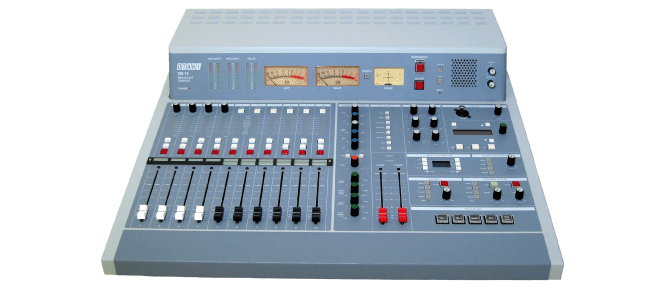| DB-10 Digital On-Air Console |
| This product has been discontinued. |
|
Main Features
|
 |
| The DB-10 console's digital audio I/O (four AES/EBU inputs, two SPDIF inputs, two AES/EBU outputs, one SPDIF output) supports 32 kHz-96 kHz sampling (max. 48 kHz for SPDIF). The DB-10 has ten input channel faders. Channels 5-10 are provided with an input A/B switching function. The four channels of microphone inputs are always connected to channels 1-4 (fixed). The remaining two line input channels, six stereo analog input channels, four AES/EBU input channels, and two SPDIF input channels can be freely routed to the A/B inputs of channels 5-10 (maximum configuration: four mono channels + six stereo channels (16 paths in total), minimum configuration: ten mono channels (10 paths in total). |
- Sample Rate Converters in All Digital I/O: The sample rate converters used in the reputable Otari FS-96 are provided in all of the digital inputs/outputs as standard. Operators do not have to worry about the sample rate of the device to be connected if it ranges from 32 kHz to 96 kHz (up to 48 kHz for SPDIF).
- One-Man Operation: Sophisticated monitor control and memory functions aid One-Man operation required especially for small On-Air desks. Also, switching back to Two-Man mode can be done easily and instantly. It is designed to be flexibly applicable to various On-Air applications.
- 99 Snapshots: The DB-10 can store the following setups in its internal memory: 99 snapshots, 9 projects (console settings), and 20 compressor presets. By connecting the DB-10 to an external PC via RS-232, snapshots and projects can also be saved/loaded easily. By copying the data files, a DB-10 in another studio can recall the desired setup instantly.
- Expandability: To increase the number of channel faders, DB-10 consoles can be cascaded by connecting the first DB-10's PGM output from the AES/EBU output to the second DB-10's AES/EBU input, the PGM buses are shared. A maximum of four DB-10's can be cascaded, and in this configuration the maximum delay time is less than 4.0 ms. In the cascaded consoles, the talkback signal is shared: a talkback microphone on a DB-10 can send signals to the talkback buses of all of the DB-10's.
- Password Protecttion: With the password protect function, certain items in the menu system can be made accessible to only specified users. There are two user levels (super user and ordinary user), and the DB-10 differentiates the users by the password used to log in. Also, specified buttons can be locked out to prevent misoperation.
- Fail-safe Operation: One of the unique features of the DB-10 is the fail-safe operation: if the digital system should malfunction, pressing the EMG button connects one microphone path and one stereo line path to the program bus to feed the minimum audio signals to the main output.
- Support for Redundant Power Supply (Option): The separate power supply unit supports 100-240 VAC.the console can be used in an OB van. By adding one more power supply unit, the power line can be redundantly duplexed for fail-safe operation.
|
|
 home
home home
home